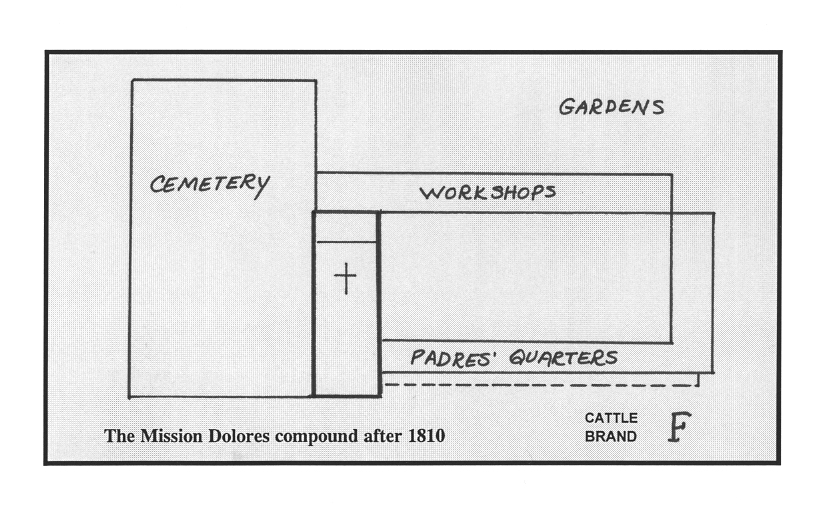| ||||
|
| ||||
|
MISSION
SAN FRANCISCO DE ASIS
3321 Sixteenth Street
San
Francisco, CA
94114
Established: October 9, 1776
By: Father Francisco Palóu, a companion of Father Serra at Carmel Mission.
Order: 6th of the 21 missions.
Location: On San Francisco Bay near the stream Arroyo de Nuestra Señora de los Dolores (Stream of Our Lady of Sorrows), named by Juan Bautista de Anza.
Named: In honor of St. Francis of Assisi (1182-1226), founder of the Franciscan Order in Italy. More often called Mission Dolores.
California Historical Landmark No. 327
DESIGN OF THE MISSION
Church: 114 feet long, 22 feet wide; made of adobe, with tile roof and tile floors.
Style: Simple, clean lines. An exterior balcony crosses the front, supported by four Corinthian columns flanking a small arched entrance. There is no bell tower; the three bells ( the original ones) hang in niches in a loft above the entrance. The bells were cast in Mexico, one in 1792 and the other two in 1797. Rawhide thongs are used to hang the bells, and also to lash together the redwood ceiling beams inside the church. This mission is distinguished by the redwood used in the interior, the ceiling beams decorated in brightly painted native designs, and the wooden columns painted to look like marble. Originally, outside stairs led to the choir loft.
Walls: Four feet thick.
Mission Compound: Rows of buildings were placed around a patio to provide living quarters, storerooms, workshops, a granary (150 feet long), and an infirmary for the Costanoan Indians who lived at the mission (a necessity here, where the damp air slowed recovery from diseases brought by the Spanish).
Mission Grounds: There was neither space nor good soil for growing crops. This is part of the reason that Mission Dolores did not become as prosperous as other missions.
Activities included making pottery and weaving blankets on large looms. The mission supplied all of the blankets for the nearby presidio (fort). A major industry was that of being a shipping center. Hides and tallow were sent from other missions to San Francisco, where the mission staff oversaw the trading of these products with ships from Spain and New England. Mission women were skilled in tanning the hid.
The cemetery on the mission grounds grew at an alarming rate due to the high incidence of illness. Over 5,000 Indians are buried here, many in unmarked graves.

EARLY HISTORY
1769 Portolá’s expedition found the large bay now known as San Francisco Bay. The name had been given to a smaller bay (now Drakes Bay) in 1597 by a Spanish explorer, Sebastián Cermeño.
1776 Lt. Col. Juan Bautista de Anza led a group of settlers overland from Mexico, 1,000 miles to San Francisco Bay; he selected sites for a presidio and mission. On June 29 Father Palóu dedicated the site and building began. October 9, formal founding of the mission with dedication of a church (wood poles plastered with mud, thatched roof) amidst great celebration of flags, feasting, a parade and firecrackers.
1782 Father Palóu moved the mission about 1,100 feet west; new wooden church built.
1791 Church made of adobe bricks dedicated on August 2.
1798 Quadrangle buildings completed.
1810 Façade with balcony and bell niches added.
1834 Mission secularized, taken from the Catholic Church; portions of the quadrangle were sold or leased to businesses.
1845 Mission lands sold; during the next few years the land was used for bull-and-bear fights, duels, horse racing, and taverns.
1857 Mission returned to the Catholic Church; parts of buildings still leased for private use.
MISSION DOLORES TODAY
The buildings in the mission compound disappeared over the years, but the mission church has changed little since the 1790's, despite the catastrophic changes all around it. It stands as the oldest building in San Francisco. The church and a portion of the cemetery are all that remain of the original mission.
By 1876 the chapel was considered too small to serve as the parish church for the growing city of San Francisco, and a large Victorian-style church was built right next to the mission church. The 1906 earthquake did not damage the mission church, but the larger church, now known as the Mission Dolores Basilica, had to be rebuilt.
The Mission Dolores church has never been rebuilt; what remains has been preserved in close to its original state. In 1917 steel beams covered with cement on the exterior and steel trestles supporting the roof were added. Since the 1989 earthquake, a $2 million refurbishing has stabilized the building, cleaned the interior, and repaired the gravestones in the elegantly planted, historic cemetery.
In the mission church is the original altar, considered the finest and oldest in any of the 21 missions. A room at the back of the church serves as a museum. It has the register showing baptisms dating from 1776. Services are occasionally held in the Mission Church. The feast of Dolores, Our Lady of Sorrows, is celebrated in September.
